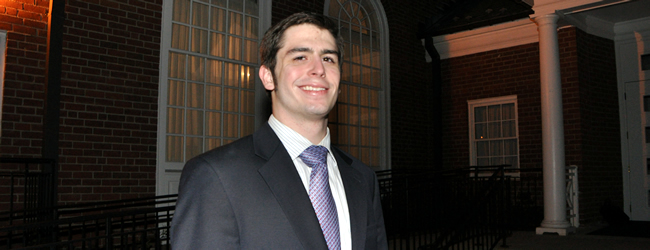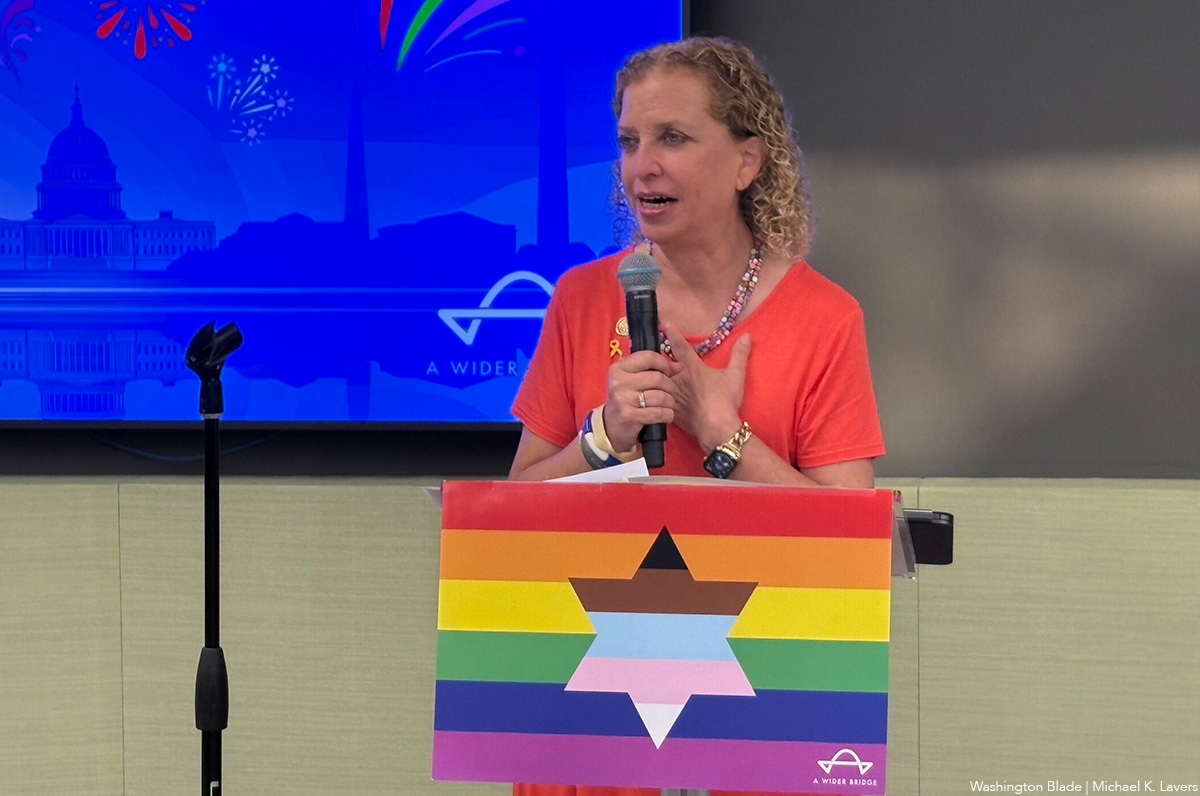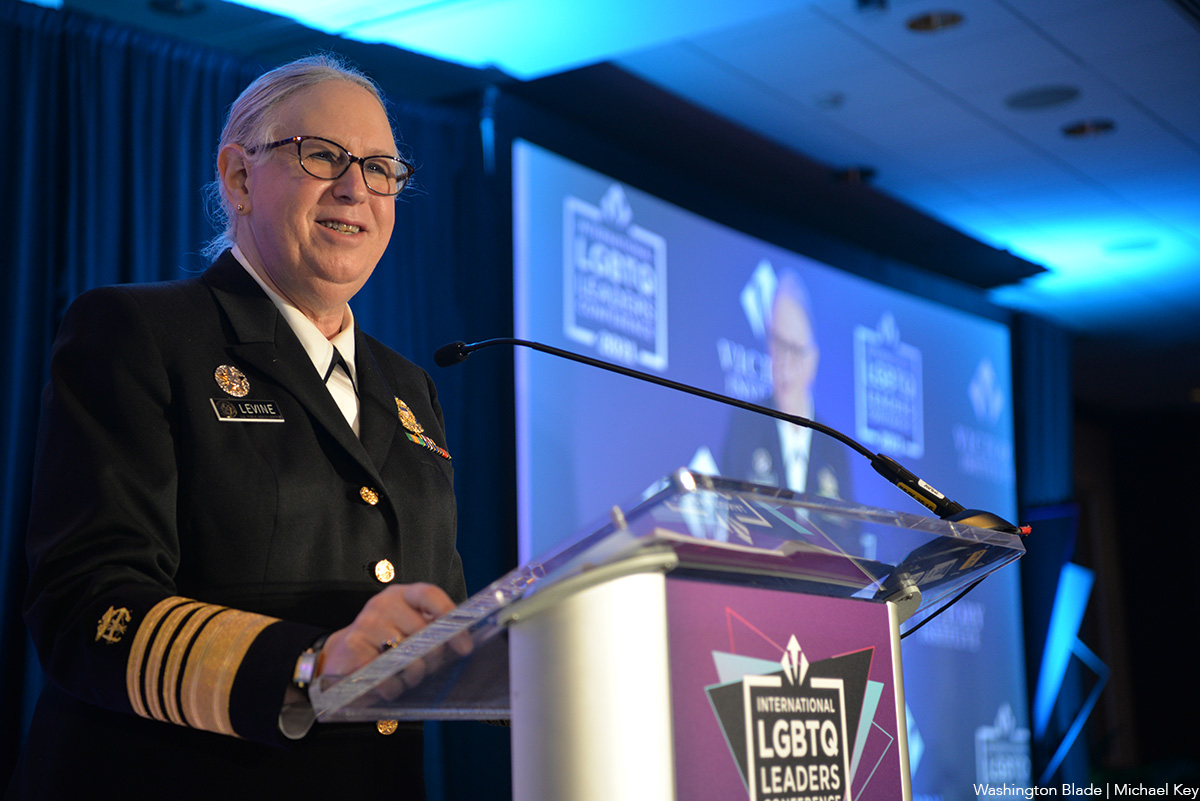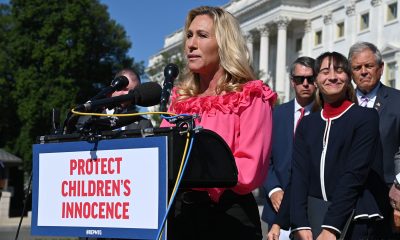National
Latter-day doubts?
Local LDS member recalls suicide attempt, but remains in Mormon church


‘I felt like I had to choose which half of me had to die,’ said David Baker, a local gay Mormon who attempted suicide in 2008. (Blade photo by Michael Key)
David Baker is living what he calls the “ultimate paradox.”
Like many 21-year-old gays in the D.C. area, Baker spent last Saturday at Town as he does many weekends. A drag show is taking place downstairs, but he and his friends went to the upper level to dance to the latest remixes.
“I started going clubbing shortly after I came out,” he said. “But I don’t go all that regularly — probably once a month.”
But on Sunday, the situation is different. After donning his best church clothes, the Salt Lake City native who now lives in Rockville, went to a Mormon church in D.C. for a three-hour block of weekly service.
Activities included hearing speakers from within and outside the congregation and scripture discussion. Baker, a University of Utah graduate, is also co-chair of the cultural events committee and helped work to plan social events with other church members.
Baker’s presence among his congregation is distinct because he’s openly gay in a religion known for its hostility to homosexuality and opposition to same-sex marriage. The Mormon Church earned scorn from many in the LGBT community in 2008 for taking a lead role in backing Proposition 8 in California, which ended same-sex marriage there.
“It’s the ultimate paradox,” Baker said. “It’s been a struggle not just in dealing with my sexuality, but in the reactions that I get from church members sometimes or the reactions that I get from the gay community.”
Even though he stands out for being gay, Baker said he’s able to mingle with other churchgoers and voice his opinion that he’s the same as any other Mormon despite his sexual orientation.
“Lots of people tune me out, but I try and approach it from a concept that we are all children of God, that we are sinners and we are all imperfect,” he said. “So to judge one sin as being worse than others, and my quote-unquote sin being worse than yours is absurd. And that seems to be a message that people understand.”
His path to personal acceptance hasn’t been easy. Baker once considered seeking out shock therapy to alter his sexual orientation as well as participation in Evergreen, the Mormon Church’s reparative therapy program. Such programs were long ago discredited and repudiated by medical professionals.
“I had come out to my family and a couple of friends and it wasn’t so much, ‘Oh, dang it, I’m gay,’ it was, “OK, I’m gay. I accept it. How does this comport with my faith?” he said. “So, I spent pretty much just every waking hour just poring over scripture, poring over words of prophets, poring over everything I could find on sexuality and religion.”
In 2008, Baker attempted to commit suicide by taking an overdose of pills. His roommate found him and took him to a local hospital for treatment.
“I felt like I had to choose which half of me had to die,” he said. “And I got to the point that I thought if half of me has to die, and I still won’t know the truth, why not just kill all of me and then I can finally know the truth?”
While undergoing treatment, Baker said a psychologist suggested to him there could be a distinction between the word of God and the guidance of the church. His roommate came to visit him and made the same observation in the exact same words.
“It sort of caught in my mind that maybe there’s a distinction between what God is saying and what the Prophets and the Apostles are saying,” he said. “Maybe these leaders of the church are Mormon and everything they say is not a direct fact from God, but instead tinged with their own personal beliefs, however flawed they might be.”
Baker is one of many other gay Mormons in the D.C. area who continue to practice their faith despite the religion’s position on homosexuality.
About 60 Mormons or former Mormons are affiliated with the D.C. chapter of Affirmation, a group for LGBT members of the Church of Jesus Christ of Latter-day Saints.
Fred Bowers, Affirmation’s D.C. chapter leader, said about one-third of those on his organization’s mailing list still identify as Mormons and participate in the Mormon church, although to varying degrees.
“Some people may go only to the church on Sunday and some may be more active with other things the church is doing through the week,” Bowers said. “And some may be there active, but they only participate in what they select, but there are a good number that actually do still attend church.”
Those who are Mormon and openly gay face challenges in adhering to their faith. For example, Mormons engaged in same-sex relationships aren’t permitted to attend special services, such as weddings, in Mormon temples. Those who are sexually active in opposite-sex relationships outside of wedlock or those who consume alcohol are similarly unable to attend.
But Bowers said many LGBT Mormons stick with their faith simply because they truly believe in the church’s teachings or because their families have a long history with the religion.
“They’ve grown up with this.” Bowers said. “Just like an Episcopalian or Catholic or what have you, we still believe that. It hasn’t changed just because we’re gay or lesbian. We still believe in that church and we still believe in the principles of it.”
That’s the situation for Baker, who said he still considers himself a Mormon because he believes in the Gospel as presented by the church and because “they have the most truth.”
“That being said, I don’t think that they have it all,” he said. “One of the core articles of faith of the church sort of says that blatantly. It says that we believe all that God has revealed isn’t all that he’ll reveal, and we believe that he’ll yet reveal many great important things. So it’s very much an ongoing, open canon.”
Still, Baker said he’s adapted Mormon dogma into his own views of his sexual orientation. He said he doesn’t plan to have sex until he finds another man to marry — similar to how many straight Mormons abstain from sex until after they receive their nuptials.
“For me, no sex before marriage means a legal marriage because the church does recognize legal marriages — the traditional kind naturally — that aren’t performed in the temple,” he said. “And so, in my mind, that same non-temple civil ceremony would be recognized by God.
‘Wickedness never was happiness’
The difficulty of being Mormon and openly gay became particularly pronounced last week when a high-ranking leader of the church made anti-gay remarks during the 180th semi-annual general conference in Salt Lake City.
Boyd K. Packer, president of the Quorom of Twelve Apostles, called same-sex attractions “impure and unnatural” and characterized efforts to advance same-sex marriage across the country as attempts to “legalize immorality.” Additionally, he suggested people can change their sexual orientation, which can be overcome through prayer.
“We must understand that any persuasion to enter into any relationship that is not in harmony with the principles of the Gospel must be wrong,” he said. “In the Book of Mormon, we learn that ‘wickedness never was happiness.’”
Packer, who as an apostle is supposed to be delivering words directly from God, made the remarks to a crowd of 20,000 people in attendance and millions more watching the sermon via satellite transmission in churches and homes throughout the world.
For many gay Mormons, the words stung. Baker said he “cringed” as he heard Packer’s remarks and left the room where he and others had been viewing the sermon. He then realized he had to watch the entire remarks so he could respond to them later.
“I went back and watched the whole thing, and as I was listening to his words, I just felt frustration and I was very upset by what he was saying because it went against where the church has gone for the last five or 10 years,” he said.
Bowers said the remarks were particularly unfortunate in the wake of recent suicides of gay teens who took their lives after they were bullied and harassed and were disruptive to the dialogue that Affirmation had been pursuing with lower-level Mormon leaders “to heal the damage that was done by Prop 8.”
“They’re working so hard to get some sense of support and everything that we’re working to do that, and then this statement comes along that’s not very helpful,” Bowers said.
Changes were made to the speech in an online version of the remarks published later in the week. Packer’s reference to inborn “tendencies” was switched “temptations.” A question of “Why would our Heavenly Father do that to anyone?” was removed entirely.
Baker said another noteworthy change was the sermon had been downgraded from the level of revelation to a less stringent guide that Mormon church members would do well to follow.
“Before in the mindset of members of the church, it’s been seen as revelation even though it’s never been explicitly said as such,” Baker said. “To have that downgraded from everyone thinking it’s revelation … to actually, no, it’s just a guide, is really big.”
Kim Farah, an LDS spokesperson, said speakers have the opportunity to make changes to clarify their intent on the Monday following every general conference and the changes made to Packer’s sermon were in line with this practice.
“President Packer has simply clarified his intent,” she said. “As we have said repeatedly, the Church’s position on marriage and family is clear and consistent. It is based on respect and love for all of God’s children.”
Even with the corrections, Packer’s sermon has invoked the ire of the Human Rights Campaign, which pounced on the Mormon leader’s remarks.
Joe Solmonese, HRC’s president, called the sermon “inaccurate” and “dangerous” and said it could lead to more LGBT suicides similar to those that took place in the last month.
“When a faith leader tells gay people that they are a mistake because God would never have made them that way and they don’t deserve love, it sends a very powerful message that violence and/or discrimination against LGBT people is acceptable,” Solmonese said. “It also emotionally devastates those who are LGBT or may be struggling with their sexual orientation or gender identity.”
HRC launched a petition campaign against Packer for his remarks following his sermon. On Tuesday, the organization delivered to Mormon Church headquarters a petition signed by 150,000 people asking the leader to correct his remarks further.
Fred Sainz, HRC’s vice president of communications, said the response to the initiative against Packer is the largest for any petition campaign in the organization’s history.
“I think it was the impact of Elder Packer’s words,” Sainz said. “Any one of those issues would have drawn significant scorn from members of the community and our fair-minded straight allies, but when you lump all of them into one sermon, and it comes from the second-highest ranking official of the Mormon Church, I think it rises to the level where people are going to pay attention and demand change.”
Sainz said HRC is seeking a further correction from the Mormon Church because Packer’s remarks were “factually and scientifically untrue.”
“They’re inaccurate,” he said. “And so, they owe the factual record a revision to reflect what is true.”
Michael Otterson, an LDS spokesperson, responded to HRC’s efforts by saying that while the church disagrees with the organization on many issues, they have some “common ground.” For example, Otterson said the church denounces the acts of bullying that led to numerous gay suicides in the past month.
“We join our voice with others in unreserved condemnation of acts of cruelty or attempts to belittle or mock any group or individual that is different — whether those differences arise from race, religion, mental challenges, social status, sexual orientation or for any other reason,” Otterson said. “Such actions simply have no place in our society.”
Otterson maintained the church believes any sexual activity outside of marriage is wrong and marriage should be exclusive to one man and woman. Still, he said these beliefs “should never, ever be used as justification for unkindness.”
“The church recognizes that those of its members who are attracted to others of the same sex experience deep emotional, social and physical feelings,” he continued. “The church distinguishes between feelings or inclinations on the one hand and behavior on the other. It’s not a sin to have feelings, only in yielding to temptation.”
HRC’s effort to draw attention to Packer’s remarks has earned mixed reviews among some gay Mormons. Bowers said HRC’s efforts at drawing attention to Packer’s remarks has been helpful in moving the church to talk about LGBT Mormons in a more positive way.
“This event was very helpful as they did release a statement,” Bowers said. “We’ll look forward to probably hopefully some more positive statements, such as the one they made about … no one should be bullied for anything. They were in agreement that everyone had a right to be in a safe space.”
But Baker was skeptical about the impact that the 150,000 signatures from outside groups like HRC would have on Mormon leadership because he doubted many of the names were from people within the church.
“I don’t think the HRC campaign is going to be that effective in affecting the church, but I definitely think it is proven effective in galvanizing a lot of people for their cause,” he said.
Baker also said the HRC campaign is energizing the core following of the church and noted new Facebook groups such as “I Love Boyd K. Packer” have emerged suggesting that the LGBT organization is bullying the church.
“I think that there’s going to be a bigger fallout of this from inside the church,” Baker said. “And from a member’s perspective, it’s going to be rally together all the other members and be like, ‘Look these people are attacking us. We’re being persecuted.’”
Sainz maintained HRC’s initiative is “not intended against Mormonism” and said millions of fair-minded Mormons “welcome LGBT people and want to encircle them in love and acceptance.”
“We don’t take exception to the Mormon religion,” Sainz said. “Our issue is with Elder Packer’s sermon and it’s with the Mormon Church hierarchy’s conduct on some of these issues. So that is an important distinction that we make.”
A change in the membership core?
As the public campaign between Packer and HRC plays out, a more under the radar effort has also been taking place with LGBT Mormons seeking change within the church — particularly in the wake of the church’s role in Prop 8.
On Sept. 19, Marlin Jensen, a general authority of the LDS Church, held a meeting in Oakland, Calif., with about 90 Mormons who reportedly voiced their disappointment over the church’s involvement in Prop 8 as well as other positions related to LGBT people.
According to Mormon writer Carol Lynn Pearson, some speakers expressed anger that Prop 8 had given Mormons “a license to hate.”
After listening to the stories, Jensen reportedly arose and through tears said, “I know that never in my life will I experience an hour quite like this one” and “to the full extent of my capacity I say that I am sorry.” Still, he never said during his remarks that he felt the LDS support for Prop 8 was an error.
The meeting itself, in addition to Jensen’s comments, was notable for many in the Mormon faith — particularly in light of the fact that apologies from church leaders are uncommon for any reason.
Baker said he thinks the event is “indicative of more of a change within the membership core.”
“The mindset of the membership just sort of realized that, ‘Wow, the church has been really rallying around Prop 8, which has been going on for two years,’” Baker said. “A lot of people are starting to sit and ask themselves, ‘What am I really supporting here?’”
Bowers also said the meeting reflects how Mormons are becoming more aware of LGBT people in their membership.
“They now know from working with them or seeing them come to church and doing their callings and wanting to do things that Mormons do in the church that we are whole, good people,” Bowers said. “Some of that attitude, I think, has changed very significantly based on the work they’ve being doing out in Oakland.”
Baker said he thinks the meeting that took place in Oakland represents how change within the church and its views on homosexuality could take place over time.
“The way the church is set up is it’s going to be something from the inside that changes it — the membership themselves over time grows to sort of recognize homosexuality more rather than just going from a top-down approach,” he said.
In the meantime, Baker plans to continue attending church service as he looks for the right man to marry while occasionally hitting the clubs on the weekend.
“I believe that they have homosexuality wrong and that over time, that might change,” Baker said. “But in the meantime, I still honestly believe in the church. And they do accept me and they don’t hate me, but it is an interesting razor-thin line to be walking.”

A Wider Bridge on Friday announced it will shut down at the end of the month.
The group that “mobilizes the LGBTQ community to fight antisemitism and support Israel and its LGBTQ community” in a letter to supporters said financial challenges prompted the decision.
“After 15 years of building bridges between LGBTQ communities in North America and Israel, A Wider Bridge has made the difficult decision to wind down operations as of Dec. 31, 2025,” it reads.
“This decision comes after challenging financial realities despite our best efforts to secure sustainable funding. We deeply appreciate our supporters and partners who made this work possible.”
Arthur Slepian founded A Wider Bridge in 2010.
The organization in 2016 organized a reception at the National LGBTQ Task Force’s Creating Change Conference in Chicago that was to have featured to Israeli activists. More than 200 people who protested against A Wider Bridge forced the event’s cancellation.
A Wider Bridge in 2024 urged the Capital Pride Alliance and other Pride organizers to ensure Jewish people can safely participate in their events in response to an increase in antisemitic attacks after Hamas militants attacked Israel on Oct. 7, 2023.
The Jewish Telegraphic Agency reported authorities in Vermont late last year charged Ethan Felson, who was A Wider Bridge’s then-executive director, with lewd and lascivious conduct after alleged sexual misconduct against a museum employee. Rabbi Denise Eger succeeded Felson as A Wider Bridge’s interim executive director.
A Wider Bridge in June honored U.S. Rep. Debbie Wasserman Schultz (D-Fla.) at its Pride event that took place at the Capital Jewish Museum in D.C. The event took place 15 days after a gunman killed two Israeli Embassy employees — Yaron Lischinsky and Sarah Milgrim — as they were leaving an event at the museum.
“Though we are winding down, this is not a time to back down. We recognize the deep importance of our mission and work amid attacks on Jewish people and LGBTQ people – and LGBTQ Jews at the intersection,” said A Wider Bridge in its letter. “Our board members remain committed to showing up in their individual capacities to represent queer Jews across diverse spaces — and we know our partners and supporters will continue to do the same.”
Editor’s note: Washington Blade International News Editor Michael K. Lavers traveled to Israel and Palestine with A Wider Bridge in 2016.
The White House
‘Trump Rx’ plan includes sharp cuts to HIV drug prices
President made announcement on Friday

President Donald Trump met with leaders from some of the world’s largest pharmaceutical companies at the White House on Friday to announce his new “Trump Rx” plan and outline efforts to reduce medication costs for Americans.
During the roughly 47-minute meeting in the Roosevelt Room, Trump detailed his administration’s efforts to cut prescription drug prices and make medications more affordable for U.S. patients.
“Starting next year, American drug prices will come down fast, furious, and will soon be among the lowest in the developed world,” Trump said during the meeting. “For decades, Americans have been forced to pay the highest prices in the world for prescription drugs by far … We will get the lowest price of anyone in the world.”
Trump signed an executive order in May directing his administration “to do everything in its power to slash prescription drug prices for Americans while getting other countries to pay more.”
“This represents the greatest victory for patient affordability in the history of American health care, by far, and every single American will benefit,” he added.
Several pharmaceutical executives stood behind the president during the announcement, including Sanofi CEO Paul Hudson, Novartis CEO Vas Narasimhan, Genentech CEO Ashley Magargee, Boehringer Ingelheim (USA) CEO Jean-Michel Boers, Gilead Sciences CEO Dan O’Day, Bristol Myers Squibb General Counsel Cari Gallman, GSK CEO Emma Walmsley, Merck CEO Robert Davis, and Amgen Executive Vice President Peter Griffith.
Also in attendance were Health and Human Services Secretary Robert F. Kennedy Jr., Commerce Secretary Howard Lutnick, Centers for Medicare and Medicaid Services Administrator Mehmet Oz, and Food and Drug Administration Commissioner Marty Makary.
Under the Trump Rx plan, the administration outlined a series of proposed drug price changes across multiple companies and therapeutic areas. Among them were reductions for Amgen’s cholesterol-lowering drug repatha from $573 to $239; Bristol Myers Squibb’s HIV medication reyataz from $1,449 to $217; Boehringer Ingelheim’s type 2 diabetes medication jentadueto from $525 to $55; Genentech’s flu medication xofluza from $168 to $50; and Gilead Sciences’ hepatitis C medication epclusa from $24,920 to $2,425.
Additional reductions included several GSK inhalers — such as the asthma inhaler advair diskus 500/50, from $265 to $89 — Merck’s diabetes medication januvia from $330 to $100, Novartis’ multiple sclerosis medication mayzent from $9,987 to $1,137, and Sanofi’s blood thinner plavix from $756 to $16. Sanofi insulin products would also be capped at $35 per month’s supply.
These prices, however, would only be available to patients who purchase medications directly through TrumpRx. According to the program’s website, TrumpRx “connects patients directly with the best prices, increasing transparency, and cutting out costly third-party markups.”
Kennedy spoke after Trump, thanking the president for efforts to lower pharmaceutical costs in the U.S., where evidence has shown that drug prices — including both brand-name and generic medications — are nearly 2.78 times higher than prices in comparable countries. According to the Pharmaceutical Research and Manufacturers of America, roughly half of every dollar spent on brand-name drugs goes to entities that play no role in their research, development, or manufacturing.
“This is affordability in action,” Kennedy said. “We are reversing that trend and making sure that Americans can afford to get the life-saving solutions.”
Gilead CEO Dan O’Day also spoke about how the restructuring of drug costs under TrumpRx, combined with emerging technologies, could help reduce HIV transmission — a virus that, if untreated, can progress to AIDS. The LGBTQ community remains disproportionately affected by HIV.
“Thank you, Mr. President — you and the administration,” O’Day said. “I think this objective of achieving the commitment to affordability and future innovation is extraordinary … We just recently launched a new medicine that’s only given twice a year to prevent HIV, and we’re working with Secretary Kennedy and his entire team, as well as the State Department, as a part of your strategy to support ending the epidemic during your term.
“I’ve never been more optimistic about the innovation that exists across these companies and the impact this could have on America’s health and economy,” he added.
Trump interjected, asking, “And that’s working well with HIV?”
“Yes,” O’Day replied.
“It’s a big event,” Trump said.
“It literally prevents HIV almost 100 percent given twice a year,” O’Day responded.
A similar anti-HIV medication is currently prescribed more than injectable form mentioned by O’Day. PrEP, is a medication regimen proven to significantly reduce HIV infection rates for people at high risk. Without insurance, brand-name Truvada can cost roughly $2,000 per month, while a generic version costs about $60 per month.
Even when medication prices are reduced, PrEP access carries additional costs, including clinic and laboratory fees, office visits, required HIV and sexually transmitted infection testing, adherence services and counseling, and outreach to potentially eligible patients and providers.
According to a 2022 study, the annual total cost per person for PrEP — including medication and required clinical and laboratory monitoring — is approximately $12,000 to $13,000 per year.
The TrumpRx federal platform website is now live at TrumpRx.gov, but the program is not slated to begin offering reduced drug prices until January.
The White House
EXCLUSIVE: Democracy Forward files FOIA lawsuit after HHS deadnames Rachel Levine
Trans former assistant health secretary’s name changed on official portrait

Democracy Forward, a national legal organization that works to advance democracy and social progress through litigation, policy and public education, and regulatory engagement, filed a lawsuit Friday in federal court seeking to compel the U.S. Department of Health and Human Services to release information related to the alteration of former Assistant Secretary for Health Adm. Rachel Levine’s official portrait caption.
The lawsuit comes in response to the slow pace of HHS’s handling of multiple Freedom of Information Act requests — requests that federal law requires agencies to respond to within 20 working days. While responses can take longer due to backlogs, high request volumes, or the need for extensive searches or consultations, Democracy Forward says HHS has failed to provide any substantive response.
Democracy Forward’s four unanswered FOIA requests, and the subsequent lawsuit against HHS, come days after someone in the Trump-Vance administration changed Levine’s official portrait in the Hubert H. Humphrey Building to display her deadname — the name she used before transitioning and has not used since 2011.
According to Democracy Forward, HHS “refused to release any records related to its morally wrong and offensive effort to alter former Assistant Secretary for Health Admiral Rachel Levine’s official portrait caption.” Levine was the highest-ranking openly transgender government official in U.S. history and served as assistant secretary for health and as an admiral in the U.S. Public Health Service Commissioned Corps from 2021 to 2025.
Democracy Forward President Skye Perryman spoke about the need to hold the Trump-Vance administration accountable for every official action, especially those that harm some of the most targeted Americans, including trans people.
“The question every American should be asking remains: what is the Trump-Vance administration hiding? For an administration that touts its anti-transgender animus and behavior so publicly, its stonewalling and silence when it comes to the people’s right to see public records about who was behind this decision is deafening,” Perryman said.
“The government’s obligation of transparency doesn’t disappear because the information sought relates to a trailblazing former federal official who is transgender. It’s not complicated — the public is entitled to know who is making decisions — especially decisions that seek to alter facts and reality, erase the identity of a person, and affect the nation’s commitment to civil rights and human dignity.”
“HHS’s refusal to respond to these lawful requests raises more serious concerns about transparency and accountability,” Perryman added. “The public has every right to demand answers — to know who is behind this hateful act — and we are going to court to get them.”
The lawsuit also raises questions about whether the alteration violated federal accuracy and privacy requirements governing Levine’s name, and whether the agency improperly classified the change as an “excepted activity” during a lapse in appropriations. By failing to make any determination or produce any records, Democracy Forward argues, HHS has violated its obligations under federal law.
The case, Democracy Forward Foundation v. U.S. Department of Health and Human Services, was filed in the U.S. District Court for the District of Columbia. The legal team includes Anisha Hindocha, Daniel McGrath, and Robin Thurston.
The Washington Blade reached out to HHS, but has not received any comment.
The lawsuit and four FOIA requests are below:


















